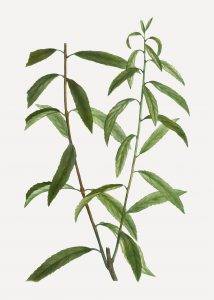
White willow – Salix alba
Description of white willow:
Salix alba L. salix alba (Silver willow) Salix alba (Salix salix) a 15 – 20 m tall tree with branches that are initially greyish-yellow, later light green. Leaves elongated-lanceolate, white silky, later greyish.
Occurrence:
In temperate regions, especially in wet places, along river banks. In our country, along streams, ditches, rivers, wet meadows.
Part to be collected:
The bark, about 1 mm thick, brown or greenish, smooth on the outside, brownish inside, which is traded as cortex salicis.
 Active substances:
Active substances:
Salicin glyeoside and tannic acid.
Harvesting and drying:
The branches cut at the end of February or beginning of March should be cut into 6-8 cm pieces and the bark cut from these pieces should be dried in an attic, in the sun or in a low-temperature oven.

White willow
Processing and marketing:
Before the spread of salicylic acid and quinine, it played a major role in medicine as an antipyretic. Today it is used in the medical field only in folk medicine. It is also used in the tanning industry. Source: Dr. Ferenc Darvas and Dr Gyula Magyary-Kossa,Domestic medicinal plants, their production, marketing, effects and medicinal uses
